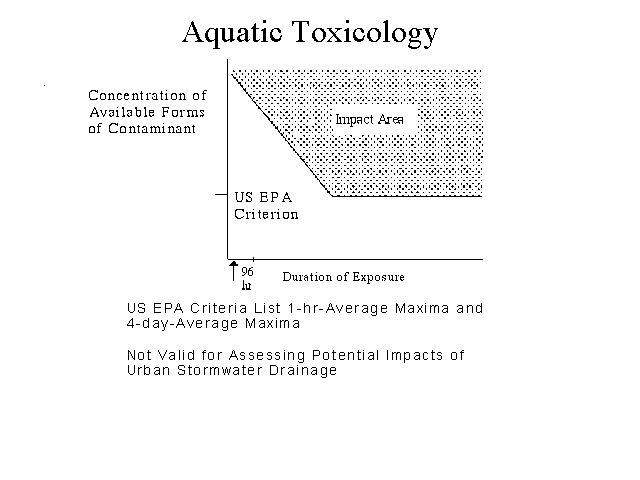
Evaluation Monitoring for Stormwater Runoff
Water Quality Impact Assessment and Management
G. Fred Lee, PhD, PE, DEE Anne Jones-Lee, PhD
G. Fred Lee & Associates,
El Macero, CA
Problems with Conventional Stormwater Runoff Water Quality Monitoring in Defining Pollution and Pollutants
Need for, and Characteristics of, Evaluation Monitoring
Upper Newport Bay Tributary Toxicity Studies
___________________
Presented at Society of Environmental Toxicology & Chemistry 18th Annual Meeting, San Francisco, CA, November (1997)

Orange County Area Highway Stormwater Runoff
Chemical Characteristics Caltrans District 8 & 12 (1994)
|
Parameter |
Detection Units |
Chapman Ave |
Walnut Ave |
|
Total Suspended Solids |
mg/l |
85 |
100 |
|
Total Dissolved Solids |
mg/l |
12 |
12 |
|
Chemical Oxygen Demand |
mg/l |
42 |
24 |
|
Oil and Grease |
mg/l |
5.3 |
2.5 |
|
Fecal Coliform |
ml |
< 2/100 |
50/100 |
|
pH |
unit |
7.0 |
9.1 |
|
Total Residual Chlorine |
mg/l |
0.45 |
< 0.20 |
|
Nitrate |
mg/l |
0.43 |
0.37 |
|
Nitrite |
mg/l |
0.051 |
0.042 |
|
Ammonia |
mg/l |
1.3 |
0.9 |
|
Total Kjeldahl Nitrogen |
mg/l |
0.89 |
1.4 |
|
Total Phosphorus |
m g/l |
120 |
130 |
|
Dissolved Phosphorus |
m g/ |
130 |
120 |
|
Sodium |
m g/ |
3000 |
1600 |
|
Cadmium |
m g/ |
< 5 |
8 |
|
Copper |
m g/ |
24 |
22 |
|
Lead |
m g/ |
48 |
160 |
|
Chromium |
m g/ |
< 10 |
< 10 |
|
Zinc |
m g/ |
180 |
140 |
|
Iron |
m g/ |
3400 |
3400 |
|
Nickel |
m g/ |
< 32 |
< 32 |
|
Magnesium |
m g/ |
1300 |
1300 |

Conventional Water Quality Monitoring - Management Approach
"Compliance Monitoring"
Monitor Concentrations of Selected Regulated Chemicals in Runoff Water
Focus of Conventional Approach Is Control of Chemicals in Discharge to Achieve Allowed Concentrations (Loads)
Conventional Chemical Approach Not Technically Valid for Stormwater Runoff - Leads to Over-Regulation and Waste of Funds and/or Under-Regulation of Unregulated Constituents

Purpose of Monitoring
Compliance Monitoring to Meet Discharge Conditions
Water Quality Problem Definition
Water Quality/Use-Impairment
Not a List of Chemical Concentrations Relative to Water Quality Standards
Must Focus Monitoring Resources on Chemical Impacts, Not Chemical Concentrations

Evaluation of the Impact of
Potentially Toxic Chemicals
Given 20 �g/L of Cu in Discharge/Runoff with the Water Quality Standard of 15 �g/L:
What Can Be Said about the Water Quality/Use-Impairment of the Receiving Waters Due to the Cu in the Discharge/Runoff?
Nothing
Need Site-Specific Evaluations of Possible Cu Impacts on Water Quality
Same Type of Problem Exists with Respect to Evaluating the Water Quality Significance of a Cu Exceedance of a Water Quality Standard in Ambient Waters
What Can Be Said about the Water Quality Impacts of Cu in a Waterbody at 20 �g/L When the Standard Is 15 �g/L?
Potential Water Quality Impact Due to Cu Toxicity
Impact Cannot Be Assessed Based on Chemical Measurements
Must Use Biological Effects-Based Approaches i.e., Toxicity Measurements to Determine if the Cu Is Toxic

Evaluation of the Impact of
Potentially Bioaccumulatable Chemicals
Given Hg at 30 ng/L in a Waterbody with a Hg Bioaccumulation-Based Standard of 12 ng/L:
What Can Be Said about the Amount of Bioaccumulation of Hg in Fish?
All That Can Be Said Is That Hg at 30 ng/L Could Bioaccumulate to Excessive Concentrations in Fish
Many Examples Where the Predicted Bioaccumulation Does Not Occur
Need Site-Specific Fish Tissue Analysis to Determine if Excessive Hg Bioaccumulation Is Occurring

US EPA Water Pollution Control Program for
Toxicity and Bioaccumulation
Focused on Chemical Concentrations
Water Pollution Control Program Should Be Focused on Chemical Impacts, Not Chemicals
Current Approach Bureaucratically Simple to Administer, but Often Technically Invalid
Tends to Over-Regulate Those Constituents for Which There Are Water Quality Criteria/Standards
Does Not Address the Vast Arena of Unregulated or Under-Regulated Chemicals Such as the Organophosphate Pesticides





Factors That Must Be Evaluated
in Translating Stormwater Runoff Concentrations
of Potentially Toxic Chemicals
to Receiving Water Aquatic Life Impacts
Runoff Waters
Concentration/Duration Profile of Potential Pollutants during Runoff Event
Analytical Chemistry of the Measurement Procedures Used
Forms of the Chemical Constituent That Are Measured in the Chemical Test Relative to the Forms That Are Adverse to Aquatic Life
Hydrologic Characteristics of the Runoff Event
Receiving Waters
Physical Factors
Currents, Tides, Mixing/Dispersion, Density Differences between Runoff and Ambient Waters
Transport/Advection
Temperature, Sunlight Penetration, etc.
Chemical Factors
Ambient Water Concentration of Toxic/Available Forms of Constituent
Aquatic Chemistry
Chemical Kinetics and Thermodynamics of Possible Chemical Transformations/Reactions
Other Chemicals in Receiving Waters
Biological Factors
Types of Organisms Present and Their Sensitivity to the Chemical of Concern
Locomotion, Diel Migration, Attraction/Avoidance to the Discharge
Concentration of Chemical/Duration of Exposure Relationship in the Ambient Waters for Potentially Impacted Organisms Relative to the Critical Concentration/Exposure Relationship for the Organisms Exposed
Importance of the Impacted Organisms to Water Quality and the Ecosystem/Ecosystem Health

Conclusions
Conventional Water Quality Monitoring Provides Limited Information on Water Quality Impacts of Stormwater Runoff-Associated Chemical Constituents
Should Shift Monitoring Resources from End-of-the-Pipe / End-of-the-Pavement, Periodic Monitoring of a Suite of Chemicals to Evaluation of Receiving-Water Chemical Impact
Far More Reliable and Cost-Effective for Defining Pollution and Pollutants
Evaluation Monitoring Provides a Technically Valid Basis for Cost-Effective Pollution Control
Evaluation Monitoring Is a Readily Implementable Approach That Can:
Determine the Water Quality Significance of the Use-Impairments
Determine the Source of the Constituents Responsible for the Use-Impairments
Provide a Technically Valid Basis for Formulating Cost-Effective Pollution Control Programs

Reference as:"Lee, G.F. and Jones-Lee, A., 'Evaluation Monitoring for Stormwater Runoff Water Quality Impact Assessment and Management,' Presented at Society of Environmental Toxicology & Chemistry 18th Annual Meeting, San Francisco, CA, November (1997)."

|
|
|
|